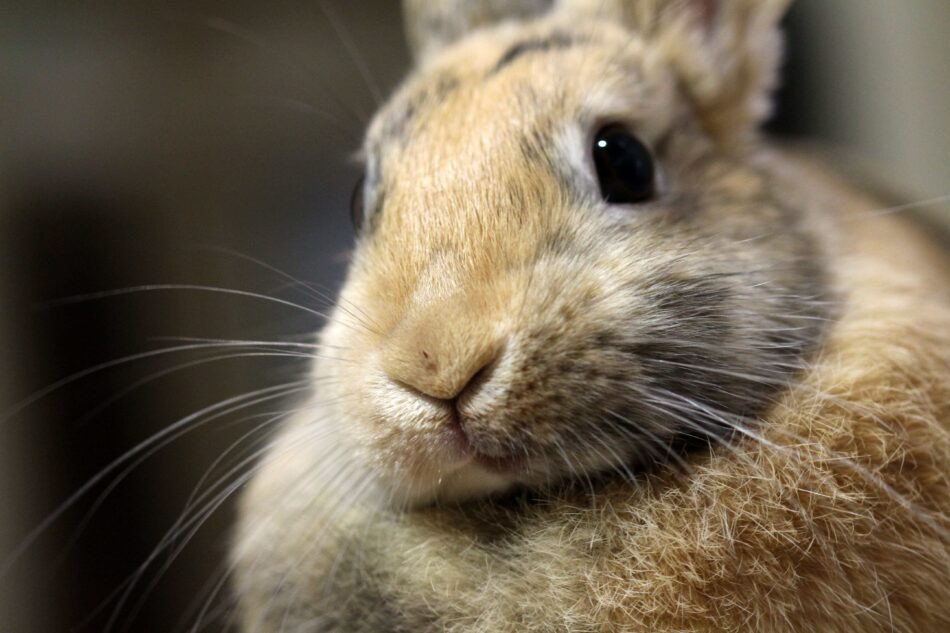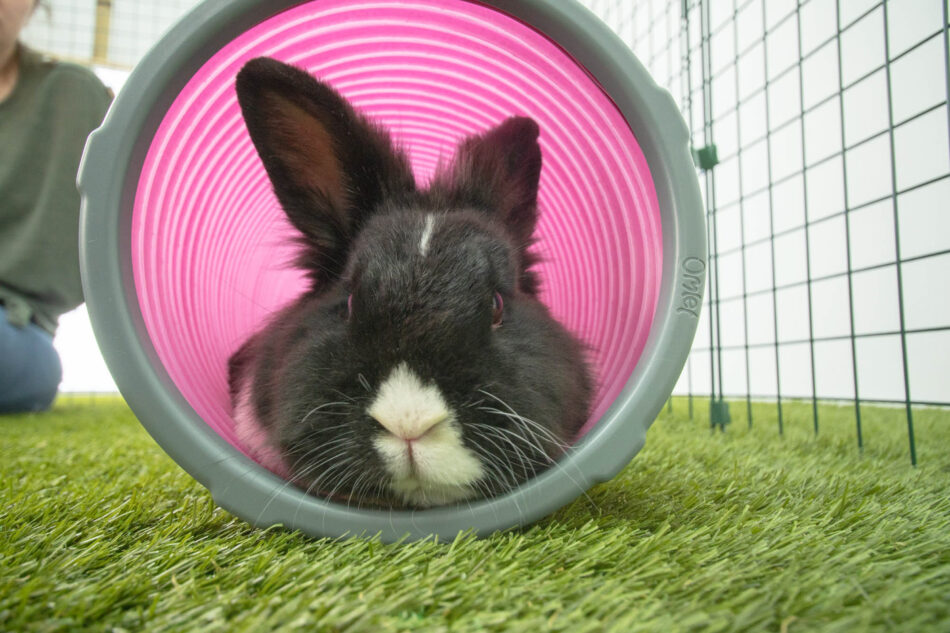Why Do Rabbits Have Whiskers?
What do you think of when you hear the word whisker? You may envision a 5 o’clock shadow on the face of a man, or maybe even a kitchen gadget. But chances are that the first thing that comes to mind is the face of an adorable animal such as a kitten or a rabbit.
We all know that rabbits have whiskers – as children, we learn to draw them onto the faces of our bunny artwork, and that they’re an essential part of any good rabbit costume. But do whiskers serve a practical purpose beyond just adding cute-factor to the muzzles they grace?
Virtually every mammal has whiskers! Whiskers have much more sensitive follicle bases than regular hairs, so while nerves do not run through the whisker itself, they are able to relay sensory input through touch. These naturally-acquired facial accessories serve the same two main functions in all species:
- To sense surroundings in dark conditions
- To serve as a measuring aid when assessing small spaces
So as a pet, does your rabbit still need these capabilities? And as an owner, is there any special care to be taken with these sensitive appendages?
The wonder of whiskers
Your pet rabbit uses their whiskers on a daily basis. In fact, they provide a virtual sixth-sense for your bunny! Rabbits don’t have the same focus or depth-perception to their vision that humans do, so their whiskers provide them with tactile sensory feedback to fill in the missing details. Even when they’re in a familiar space such as their rabbit hutch or rabbit playpen, rabbits utilize their facial “feelers” when it’s too dark to see their surroundings.
Before just bounding into any ol’ burrow, your rabbit uses its whiskers to determine whether or not they’ll fit into a tight space. Even as your rabbit runs through their Zippi Rabbit Tunnels, they’re being felt out by a rabbit’s whiskers to make sure they’ll fit!
And, new studies suggest that like other animals, rabbits are able to tell the texture of an object by vibrating their whiskers against it! Rabbits can also sense vibrations and the movement of air and water with their whiskers.
Rabbits are able to twitch and move their whiskers in an action called “whisking.” While this type of whisking may not produce baked goods, it does bring joy to the observer! Whiskers are also the first points of contact when meeting another rabbit or fellow animal with whiskers – almost like a handshake!
Whisker length and arrangement
A rabbit’s longest whiskers are as long as their bodies are wide on each side! They’re also arranged according to a specific pattern above their eyes, on their nose, and under their chins for a full range of spatial awareness. The whiskers start off shorter by their nose, and get longer in each row going toward their cheeks and tops of their heads.
The whiskers toward the front of their face act as tactile tools for feeling around in the dark, or for sensing objects directly in front of them. Due to the placement of their eyes, rabbits cannot see something that’s directly in front of their nose – they rely on their other senses to perceive what is right in front of them.
The longer whiskers above their eyes look very similar to false eyelashes! Not only does this give them a doe-eyed expression, these longer lashes also keep debris from getting into a rabbit’s eyes.
A rabbit’s longest whiskers are used primarily for gauging spaces, orienting themselves, and feeling for vibrations.
Does my rabbit need a shave?
It’s very important to never cut your rabbit’s whiskers! Since the whisker itself does not have blood or nerve supply, cutting it will not cause pain, but it will interfere with a rabbit’s natural abilities and coordination. Think of it as if you were taking eyeglasses or contact lenses away from someone who is severely near-sighted. They would be able to walk, certainly, but they would stumble, bump into things, second-guess themselves and not move nearly as quickly or efficiently as they did before. If a rabbit were to suddenly lose its whiskers, it would have to re-learn how to interact with its surroundings.
If you were to trim rather than shave the whiskers off at the base, it would relay incorrect information to the rabbit. By trimming the whiskers shorter, they would no longer be as long as the rabbit is wide. Your rabbit may then try to squeeze into spaces they have no business trying to fit into!
Whisker worries
Why are my rabbit’s whiskers falling out?
Just as they do with their coats, rabbits will shed their whiskers in a routine fashion. So, if you find a stray whisker in your rabbit’s environment every once in a while – don’t be alarmed! It’s a perfectly normal process, and soon a new whisker will grow in its place.
Will your rabbit be alright without a whisker? Don’t fret – if your rabbit is down a whisker or two, they likely won’t notice the difference!
What if my rabbit’s whisker is bent?
A bent whisker will either eventually fall off at the break, or fall out as part of the natural shedding process and will regrow as usual. Refrain from trimming the broken part of the whisker yourself because you could accidentally cut or more whiskers in the process!
Why is my rabbit bleeding from the base of a whisker?
If a whisker is pulled or twisted during rough play, it may either fall out completely, or be partially detached at the base. Whiskers are as sensitive as they are because the roots are in a hair follicle with a blood supply. A small amount of blood is normal for the sudden, unexpected removal or loss of a whisker, but if your bunny is bleeding actively, call your veterinarian! Other reasons for concern over a whisker that warrant a call to the veterinarian include:
- Inflamed base of a whisker, with or without swelling
- Oozing blood or yellow fluid from the base of a whisker
- A partially detached whisker that has not fallen out on its own after a couple of days
- Whisker loss beyond normal shedding – this could be losing multiple whiskers all at once, or whiskers not growing back
- Whiskers above the eye that turn inward, causing them to rub against your rabbit’s cornea
Create spatial awareness
Even with the use of super-appendages, rabbits need a space designed to foster and encourage their natural behaviors. Rabbits are very sensitive animals, and their whisker-wielding ways only adds to the amount of stimuli they process.
By providing the optimal environment, you’ll create a space for your rabbits to feel safe when they perceive danger, playful when they feel safe, and relaxed when they feel secure. Our line of rabbit products do exactly that, taking the guesswork out of creating the ideal habitat for your rabbit!
Our products have been thoroughly “whisked” over by hundreds (maybe even thousands!) of rabbits from around the world. And all of the whiskers agree – Omlet has the hutches, play tunnels, shelters, and accessories to keep your rabbit’s sixth sense performing its best.

This entry was posted in Rabbits
